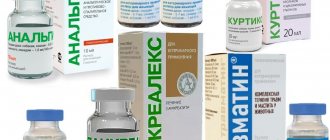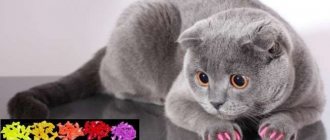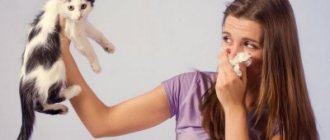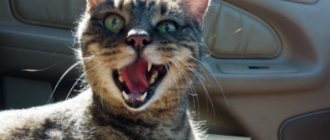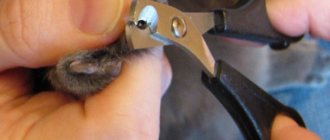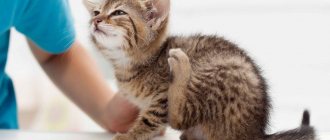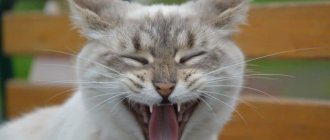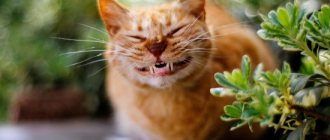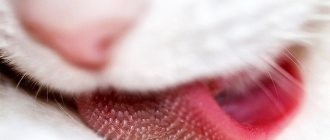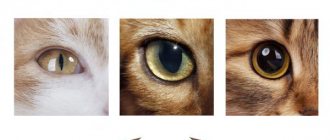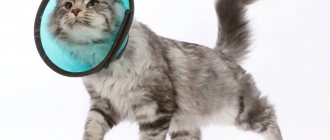If your pet is sick, ASD 2 for cats is often prescribed. The drug has a rich composition and improves metabolic and digestive processes, prevents the progression of inflammatory processes. The owner of the animal should know the mechanism of action of the drug, indications and contraindications, and also take into account possible side effects.
Veterinarians classify ASD 2 fraction for cats as hazard class 3 (moderately toxic), which means there is no negative effect on the animal’s liver and immune system.
Mechanism of action
With the help of such a drug, you can improve the digestive function of an animal.
The drug ASD 2 fraction for cats can be used externally and internally. When taken orally, the medicine has the following therapeutic effect:
- improves motility of the digestive organs;
- has a positive effect on the autonomic and central nervous system;
- stimulates the secretion of gastrointestinal glands;
- promotes the absorption of nutrients;
- improves the activity of tissue enzymes;
- stimulates the transport of ions and nutritional components across cell membranes;
- improves protein synthesis;
- promotes nutrition of skin tissue;
- increases immunity;
- normalizes metabolic processes.
When applied externally, ASD 2 fractions have the following therapeutic effect:
- eliminates pathogenic microflora;
- relieves inflammation;
- activates tissue macrophages;
- accelerates the regeneration process.
Composition and release form
A mixture for external and intrauterine use, a liquid from yellow to reddish-brown in color, which has a specific odor that mixes well with water, with the presence of flaky sediments from gray to black.
The product contains: low molecular weight organic compounds, water, and so on.
Packaged in 5, 7, 10 ml in polymer or glass bottles of 10 ml; 20, 50, 100, 200 ml in polymer.
Indications: when is the drug prescribed?
This drug can be used when an animal has lichen.
Veterinarians prescribe ASD 2 fraction for cats for the following disorders:
- lichen;
- weakened immune system;
- suffered severe infectious diseases;
- dysfunction of the central nervous system and autonomic nervous system;
- dermatitis of various etiologies;
- intoxication due to poisoning;
- inflammatory processes of the genitourinary system;
- nasopharyngeal diseases;
- any stage of cancer and metastasis;
- metabolic disorder;
- gastroenteritis;
- endometritis, especially with heavy vaginal discharge.
Instructions and dosage ASD-2
Since the biological substances that make up ASD-2 are well absorbed only with a sufficient amount of water, before starting therapy you need to make sure that the cat is not suffering from dehydration. If she drinks and urinates as usual, then treatment can begin.
When calculating the dosage, they are usually based on the weight and age of the animal. Use 1 drop per 2 kg of live weight. Therefore, an adult cat weighing, for example, 4 kg can be given 2-3 drops at a time (dissolved in a tablespoon of milk). In this case, the maximum dosage, regardless of the age and weight of the animal, is 5 drops. Frequency – from 1 to 4 times a day. Usually the remedy is given in the morning and evening, in some cases up to 3-4 times (the minimum period of time between doses is 4 hours).
The kitten should be given the minimum dose – i.e. literally the volume of the medicine should be less than 1 drop. The duration of the course also varies. The standard option is to take the drug for 5-7 days, after which a break is taken for 2 days. Therapy is then continued until stable results are achieved.
The liquid is collected using a syringe, since the medicine has a sharp, specific odor. It is unpleasant for both people and animals. The sequence of actions is as follows:
- First you need to remove the aluminum cap.
- Then insert the syringe into the rubber stopper and take out the required volume (based on 1 ml - 35 drops).
- Next, remove the needle and dip it in or into milk (a tablespoon) and quickly feed it to the cat. To do this, the syringe hole is directed directly to the root of the tongue. The liquid is squeezed out with a sharp movement.
- After this, you can quickly pour in a little pure milk, which must be drawn from another syringe (volume 10-15 ml). The milk should be as fat as possible, at room temperature or slightly higher (it can be warmed up a little just before drinking).
It is also possible to take medications externally - in the form of compresses on the affected areas (wounds, pustular formations on the skin, etc.). To do this, you need to fold sterile gauze in 4-5 layers and drop only 1-2 drops of ASD-2 and 10-20 drops of water on it (solution concentration approximately 10%, maximum 20%). Then the gauze is applied to the fur and secured with a bandage.
Note! During the course, it is necessary to carefully monitor the condition of the animal. If the cat is less active, has problems with digestion, drowsiness and other extraneous symptoms, therapy should be stopped. Resumption is allowed only after consultation with a veterinarian.
Application: how to give the medicine correctly?
The drug is prescribed to kittens with caution due to their low weight, so only a veterinarian should calculate the dosage.
It is important to adhere to the correct dosage of the drug relative to the pet’s weight.
The veterinarian prescribes ASD 2 fraction individually, based on the condition of the animal, the etiology of the disease, and body weight. The dose of the medication should not exceed the proportion of 2 drops/1 kg of weight. The instructions contain the following recommendations:
- prevention - 1 drop/5 kg of weight;
- therapy - 3-4 drops/5 kg.
The medication is given to the cat in the morning for 5 days with a break of 2 or 3 days. For cancer, the dose begins with 1 drop, increasing daily to 20 drops, and then taking the medicine in the reverse order - from 20 to 1 drop. Against lichen, it is recommended to moisten a cotton pad in the preparation and apply it to the problem area. And also for lichen, you can use ASD 3 fraction, which is intended for external use only.
Indications for use
The drug ASD-2 is a mixture of biologically active substances dissolved in water, and in the case of ASD-3, the solvent is oil. ASD-2 is used for internal use in the treatment of such diseases.
- gastroenteritis;
- dyspepsia;
- dystrophic conditions;
- digestive disorders;
- vaginitis;
- trichomoniasis;
- respiratory diseases;
- oncological pathologies;
- adverse consequences of surgery, infectious disease.
The drug ASD-3 is used externally to treat the following disorders:
- wounds (especially those that do not heal for a long time);
- pustules;
- skin inflammation;
- trophic ulcers;
- dermatitis and eczema of various origins.
It is important to understand that both ASD-2 and ASD-3 are only an aid. In most cases, they are taken together with other medications (with an interval of at least 3-4 hours). Therefore, if the veterinarian has already prescribed a specific course of treatment, you should not neglect it.
False prescriptions for the treatment of oncology in dogs and cats
Herbal medicine is a fairly popular area in the treatment of oncology in animals, but only with proper and competent handling is it possible to obtain an effect by observing all dosages and correctly and competently handling herbal preparations. Many pharmaceutical preparations are also produced based on many herbal components.
Folk remedies were originally based on herbal medicine. And they were often dealt with by specially trained people, herbalists - the predecessors of medical workers. Passing on your knowledge and skills very clearly, from generation to generation, and training the receivers for a long time.
Nowadays, “folk” refers to any remedies invented by people who are often not related to medicine. Recipes for curing all diseases of dogs and cats are not clearly communicated. Sometimes someone comes up with something on their own, but knowledgeably shares their fantastic recipes on the Internet. And now there are a bunch of simple recipes for all diseases from such “dreamers”. And hence the question: will these recipes help an animal with cancer or harm them? Most often, of course, the second option.
And so the hit parade of the most common false recipes of traditional medicine for the treatment of cancer in cats and dogs:
1. SDA 2nd faction, and it doesn’t even matter which faction. This drug does not have proven cytostatic activity, but on the contrary, it has a proven carcinogenic effect (that is, it itself is capable of causing cancer). However, almost every week at the “In Good Hands” clinic we encounter four-legged patients whose owners have been poisoned by this treatment or whose external use has led to severe consequences: necrosis (death of tissue) and sepsis (a general severe inflammatory reaction of the body).
2. The tumor eats protein. Therefore, we will not feed the dog and/or cat protein food. Another very typical misconception from traditional medicine. First, tumor metabolism is based not on protein, but on carbohydrates. Secondly, the body of an animal with cancer requires all the nutrients, and if we stop feeding the patient, then it is not the tumor that will suffer first, but the patient! The tumor will continue to obtain nutrients for itself, but will pull them out of the patient with a vengeance. And the dog’s body, and especially the cat’s, will suffer greatly, and it will not have the strength to resist the disease and the increasingly spreading tumor.
3. Also from a series of myths: Chinese mushrooms, herbs, citrus fruits, soda. All this can cause irreparable damage to the body and deprive the pet of the opportunity and chance of survival and recovery.
4. Cytostat, Metastop, Ligfol, Roncoleukin, Polyoxidonium, etc.
Here, of course, there is less damage to the body, since the drugs are not toxic, unlike ASD. But a dog or cat loses precious time without treatment, and the owner is confident that he is receiving treatment.
Nowadays, traditional medicine, as such, with correct recipes proven over generations, no longer exists; it has grown into a true medical science, which has been studied for years and improved over decades. And pseudo-traditional medicine exists, but does not help in the treatment of malignant pathologies.
There are a great variety of tumors in dogs and cats, they have different origins, and each tumor has its own treatment! Believing in one “miracle cure” is like treating diarrhea, headaches, coughs and a broken leg with one cough syrup. Everyone understands that this is impossible. Tumor processes are also different diseases, and there is no magic herb, pill, injection, lotion, etc. for all types of cancer.
The only right decision is not to take away your pet’s precious time, but to consult a doctor in a timely manner! For detailed diagnosis and selection of targeted treatment for this specific disease!
For all questions related to oncology, please contact a veterinary oncologist at the veterinary clinic #inGoodHands.
Timely detection of the disease, as well as competently selected treatment, increase your animal’s chance of recovery!
Author: Bulakovskaya
